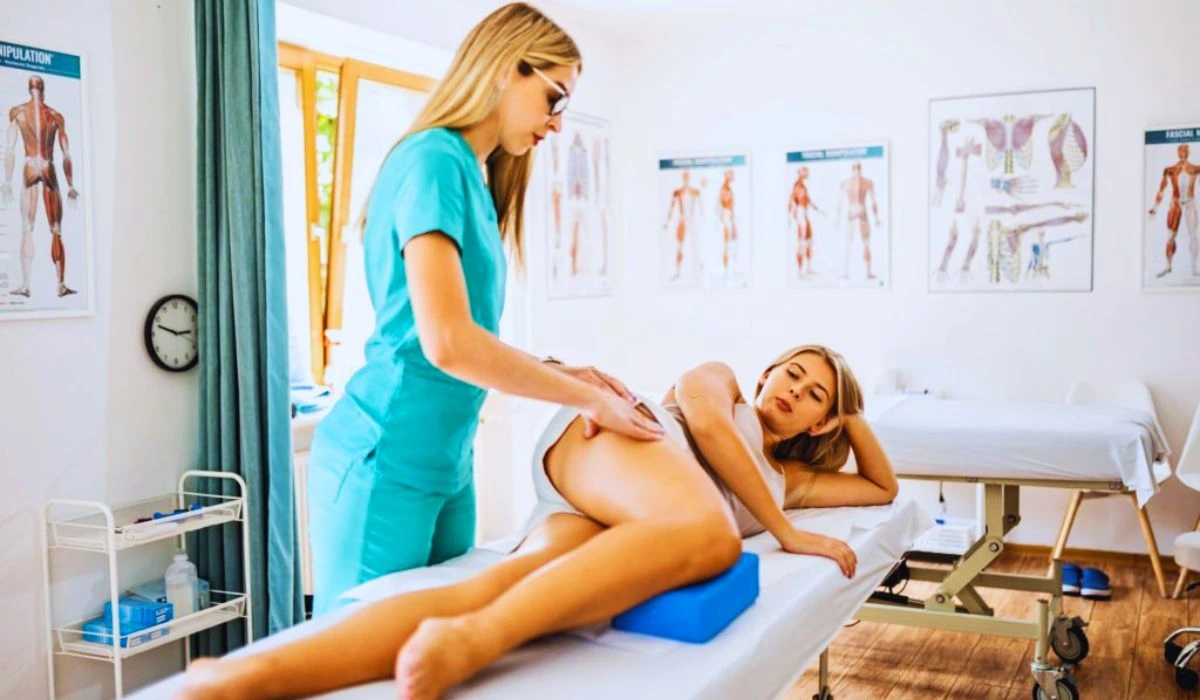A disk bulge or herniated disk occurs when the nucleus pulposus, which is the inner gel-like substance in the center of the disk, slips past the tough exterior shell called the annulus. Bulging disks are a degenerative process associated with age, mostly affecting people aged 30-50, with a male-to-female ratio of 2:1.
Although disk bulges mostly affect the lumbar part of the spine (lower back), they can occur anywhere from the neck to the lower back region. There are a number of treatment options available for this condition, ranging from anti-inflammatories or steroids to surgical intervention and physiotherapy.
In this article, we will explore how effective physiotherapy is in treating disk bulging as well as a few physiotherapy exercises that could be practiced to relieve the symptoms.
Physiotherapy For Disk Bulging
Not everybody with building disk conditions demands surgical intervention. Rather, conservative interventions like physiotherapy are often recommended as the first line of treatment for bulging or herniated disks.

These treatments provide a non-invasive, customized, and drug-free service to help us manage the symptoms and prevent recurring pain. The physiotherapy plan for each individual will be designed with regard to our clinical presentation, which involves the history of their condition, contributing factors, the behavior of their symptoms, and the functional deficits that have occurred due to the condition.
Also Check: What Is IntramuscularStimulation (IMS) In Physiotherapy? All You Need To Know
Considering these facts, it is difficult to list the typical physiotherapy treatment program for bulging disks. However, most treatment plans usually begin with passive treatments. The passive treatments may include any one or combinations of the following elements:
- Deep tissue massage: This method utilizes pressure to relieve deep muscle tension and spasms, which prevents muscle motion in the affected area.
- Hot and cold therapy: Hot therapy is used to increase the blood flow in the affected area. By doing so, it delivers extra oxygen and nutrients to the area and removes the waste byproducts from muscle spasms. On the other hand, cold therapy slows circulation, which is beneficial for reducing inflammation and pain. Physiotherapists may recommend alternate use of both to get the best results.
- Hydrotherapy: This therapy is all about utilizing water to relieve pain. In passive treatment, hydrotherapy involves simple activities like sitting in a whirlpool or taking a warm shower.
- Traction: The main aim of traction is to reduce the effect of gravity on the spine. It is done by gently pulling apart the bones to reduce the bulging of the cervical or lumbar spine.
Once your body heals from the passive treatments, physiotherapists will then start active treatments that will help improve your flexibility and muscle strength. The common elements of active treatments are:
- Core stability and muscle strengthening: Having a strong core is very important for maintaining the health of the spinal cord. This is because our core, or abdominal, muscles help the back muscles support the spine. So, when the core muscles are weak, it puts extra pressure on the back muscles. There are several core stabilizing exercises to strengthen our back and spinal cord.
- Hydrotherapy: In contrast to passive treatment, hydrotherapy in active treatment involves water aerobics to relieve the symptoms without applying much pressure to the spine.
Physiotherapy Exercises
Gentle exercises and stretches can ease the pain and promote healing by building strength, increasing circulation, improving posture, and decreasing stress on the spine. Below are 4 such exercises for pain relief from disk bulging.
- Back flexion: In this exercise, you are supposed to lie on your back and hold both knees towards your chest, and at the same time, move your head forward until you feel a comfortable stretch across the mid and lower back. 5 to 10 reps are usually preferred.
- Plank: Here you should lie on your stomach with your arms against the mat. Then lift your body so that you are resting on your forearms and toes. Hold the pose for 20 to 30 seconds and do 5 to 10 reps. This exercise engages and stretches your core.
- Cat-cow pose: Start this pose by lowering your hands and knees to the floor so that the body is in a table-top position with a flat back. Then inhale and sink your stomach toward the floor while looking up at the ceiling. As you exhale, curve your spine into an arch and let your head hang low. Repeat as a set of 10 for 3 times. This pose opens the spaces between your vertebrae and relieves the stress on the herniated disk.
- Standing extension: This is the reverse of hunching. This exercise can help push the disk back to the neutral position. Begin this by standing up and placing both your hands on either side of your lower back. Now push your pelvis forward with your hands and extend your spine back. You can do this 10 times for at least 2 to 3 sets.
Read More: What Are The Benefits Of Sports Physiotherapy?
Bottom Line
Physiotherapy is one of the most cost-effective ways to improve the quality of life while reducing our dependence on medications and surgery. Physiotherapists tailor your treatment and exercise program according to the behavior of your symptoms, causative factors, and the extent of damage the conditions have brought to your movement.
With the help of physiotherapy, you can experience a full recovery from your symptoms and improve the quality of your life.